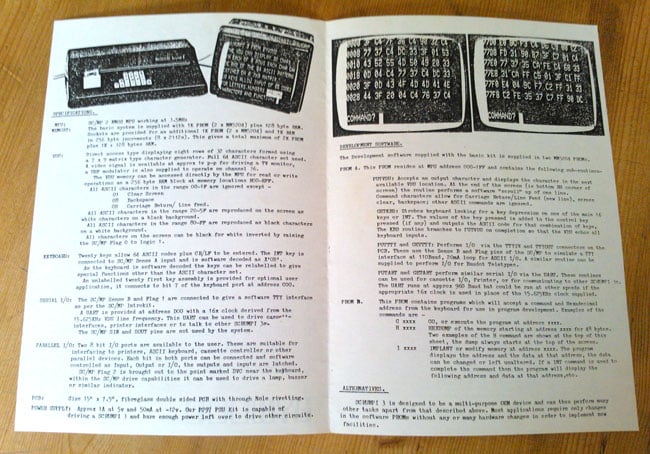Original URL: https://www.theregister.com/2013/11/29/unsung_heroes_john_miller_kirkpatrick/
Britain’s forgotten first home computer pioneer: John Miller-Kirkpatrick
The electronics genius who nearly beat Clive Sinclair at his own game
Posted in Personal Tech, 29th November 2013 10:06 GMT
Archaeologic Too few people today remember John Miller-Kirkpatrick, the enthusiastic founder, owner, manager and technical director of Bywood Electronics. He died in December 1978 at the monstrously young age of 32, less than two years before the début of the Sinclair ZX80 and the start of the UK home computing boom – for which he had helped lay the foundations.
By the end of 1978, Clive Sinclair’s Science of Cambridge was struggling to meet demand for its basic microprocessor kit, the MK14, which it had launched earlier that year. Sinclair himself was still working for the National Enterprise Board at Sinclair Radionics, the now near-nationalised firm he founded in 1962. Meanwhile, SoC’s day-to-day manager, Chris Curry, was preparing to quit in order to focus his efforts on his other business, Acorn.

John Miller-Kirkpatrick in September 1978
Both Sinclair Research, as SoC later became, and Acorn went on to become synonymous with the British home computing revolution of the early 1980s, but neither were the first firm to produce a British home computer as we might understand one today. Lynx Electronics’ Nascom 1 takes that honour.
And neither were Acorn nor Sinclair the first to produce the kind of machine that prefigured the home computer: the microprocessor evaluation kit.
John Miller-Kirkpatrick was.
John’s machine was the Scrumpi, a crude board computer which first went on sale, in kit form, at the end of 1976, more than 14 months before the arrival of Science of Cambridge’s MK14 and longer still before the Acorn Microcomputer board - aka the System 1 - made its début. Why “Scrumpi”? It was simply considered “an unforgettable name”, Miller-Kirkpatrick later said.
DIY microprocessing
When the Scrumpi was being developed, it wasn’t hard to buy a microprocessor - an "MPU", as they were called back then - but if you wanted to use it, you pretty much had to build your own computer. People like Acorn’s Steve Furber and Sophie Wilson, and Ian Williamson, who created the progenitor of the MK14, did just that.
In the US, MITS had launched its Altair 8800 kit micro in December 1974, the month the January 1975 issue of Popular Electronics which promoted this new device was published. Other US kit computers, most notably the IMSAI 8080, soon followed. None of them went on sale in the UK until 1976, and when they did they were expensive.
That made them unrealistic choices for the small but growing number of British electronics buffs who had been turned on to microcomputer technology, largely by a spate of articles on the subject in the electronics hobby press. Most were not sufficiently expert to design a machine from first principles, they just wanted to get a handle on the new technology. But they certainly didn’t want to pay a fortune to do so.
One alternative to the pricey American imports was to use one of the processor manufacturers’ own evaluation boards, created to allow potential customers to test their products. These were basic board computers, typically with a set of eight LEDs as a rudimentary display, and a calculator-style keyboard for punching in machine code routines in hexadecimal notation. In the US, the likes of Intel, Motorola, National Semiconductor, Zilog and others had realised that amateurs were as interested in fiddling with this kind of kit as professional engineers were, and had begun to devise lower-cost versions for the new enthusiast market.
In 1976 these lower-cost kits were not yet widely available in the UK. Those that were could easily set you back at least £200 - the equivalent of £1,840 in today’s money - often a lot more.
Enter John Henry Alexander Miller-Kirkpatrick and the Scrumpi, which went on sale for just £65 but soon fell to £56, affordable for almost every electronics enthusiasts and MPU buffs. Not quite throw-away money, perhaps, but sufficiently inexpensive for fans to take a punt.
Very cheap micro, anyone?
“We eventually decided that the best approach was to take an MPU and add as few extras as possible onto it in order to get a minimum system running so that the capabilities of MPUs could be investigated,” Miller-Kirkpatrick wrote of the machine in 1978. “After designing and building our own prototype board for SC/MP, we decided that if a company like ours could use it for both training and development, then so could other people.”
Scrumpi was released by Bywood Electronics, a company Miller-Kirkpatrick had registered in 1971 and begun formally running in 1972 as a mail order supplier of “LSI technology components to small volume users” and to “deal exclusively in high technology components”. It soon developed a nice sideline in kits for gadgets such as digital clocks, timing and counting circuits all based on the components Bywood sold.
In the early days, Bywood operated out of Miller-Kirkpatrick’s Hemel Hempstead home. Later they would rent a shop-cum-office further down the Hertfordshire town’s Ebberns Road.
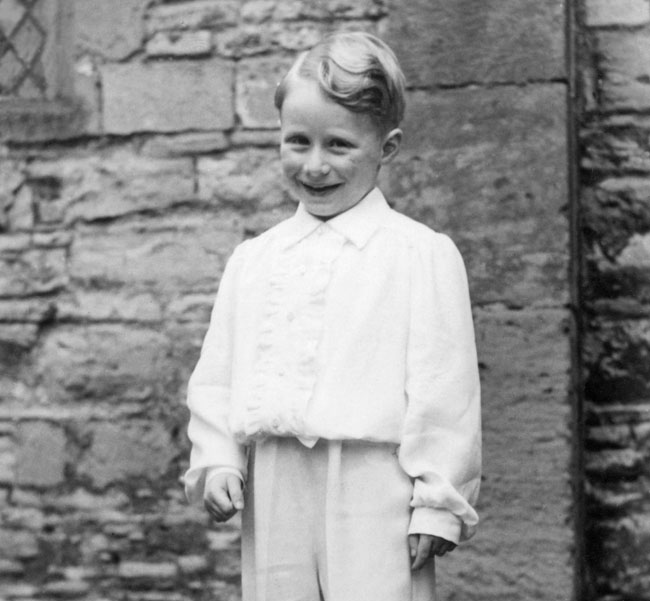
Maker in the making: John aged seven
John worked with the help of his wife, Jane, whom he met in May 1968 while she was studying fashion and textiles at the Middlesborough School of Art. They married the following October when it became clear the couple were expecting their first child. John himself was born in Coventry in August 1946, the son of Thomas Alexander Kirkpatrick and Edith Jane Fianda, respectively of Scottish and Irish descent. He did well at school and showed a strong aptitude for maths and physics - and undoubtedly electronics, a subject in which he was essentially self-taught for which he showed boundless enthusiasm.
After their marriage, the Miller-Kirkpatricks moved to London, where the young John, eschewing college, began to hawk his electronics skills around recording studios and film and television production companies. This being the late 1960s, the Miller-Kirkpatricks leapt into the London bohemian scene, becoming pals with rock’n’roll stars, fashion and jewellery designers and film makers. It’s possibly around this time that John made the acquaintance of Gerry Anderson, with whom he remained close friends throughout his life.
Sci-fi addict
A classic boy nerd if there ever was one, Miller-Kirkpatrick’s other passions, beyond electronics and his young family - Kirsten was born in 1969, Ashleigh in 1971 – were science fiction and movies. During 1973, he designed and built a series of digital clocks for Anderson’s Space 1999, then in production ahead of its 1975 debut.
Now in his mid-20s, and with his fighter-pilot good looks, Miller-Kirkpatrick represented a new breed of electronics devotee. He was no pipe-smoking, tie-and-tanktop wearing middle-aged tinkerer of the 1960s electronics scene - the sort of chap who read "serious" magazines like Practical Electronics and Wireless World - but a hip youngster of the 1960s and '70s, fascinated by microelectronics and eagerly looking forward to something other than a long, boring nine-to-five career culminating in a gold watch, a pat on the back and retirement.
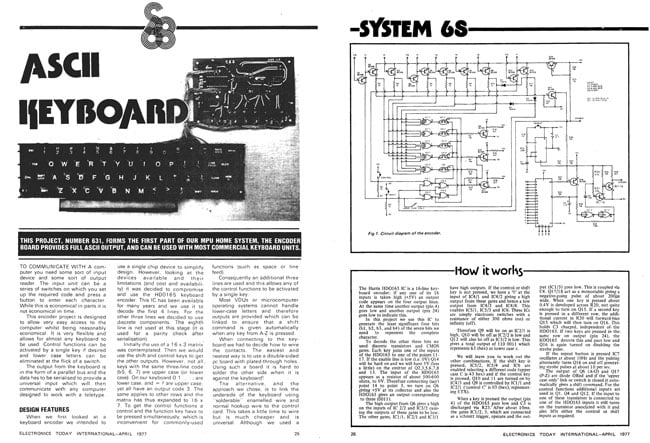
Electronics Today International described a DIY desktop, the System 68, during 1977
Click for a larger image
Always a something of a maverick, Miller-Kirkpatrick couldn’t see himself working for anyone else, and this yearning for independence led him to establish Bywood. He was just 26. His wife helped out with the admin and marketing.
Not merely a competent electronics constructor, Miller-Kirkpatrick quickly proved himself an articulate advocate of the hobby, and he soon came to the attention of Halvor Moorshead, Canadian editorial director of Electronics Today International magazine. The publication had been founded in Australia in 1971 but the following year it was acquired by Moorshead, who promptly relocated it to London.
ETI was brash, cheeky and modern. Unlike the long-running, well-established Practical Electronics, ETI looked like a magazine of the 1970s, not an engineers’ journal from the 1950s or 1960s. Practical’s writers and staff were all known by their initials and surnames; ETI was on first-name terms with its readers.
A new mag for a new generation
It suited Miller-Kirkpatrick perfectly. He started writing articles for the new title and, in 1973, was commissioned to pen its monthly "Electronics Tomorrow" column. He contributed copy to every issue until just a few months before his death, and his byline appears in almost all of the electronics and personal computing magazines of the period. He was asked to write for the launch issue of Personal Computer World, for instance.
John was soon a much-in-demand public speaker too, and both he and his wife were often travelling to conferences and exhibitions to promote Bywood products. John would usually be called upon to give talks about developments in microelectronics and to discuss where he thought the technology was heading.
He knew his stuff. In an obituary to his friend, Halvor Moorshead later wrote: “When I first met John I can’t quite remember, but it was probably shortly after he had developed the first digital clock that I’d ever seen. This would have been in 1971 or 1972 - way before chips that make these things so simple today. The circuit comprised a mass of TTL and the whole thing had been worked out from first principles.
“Yes, John was one of the few people I know who could work from first principles.”
Bywood was moderately successful too. By 1976, Miller-Kirkpatrick was able to say that only 40 per cent of Bywood’s customers were the amateur electronics buffs he had originally set out to supply. Turnover for the 1976/77 fiscal year was just under £100,000. His kits had drawn in professional electronics designers, who used them as time-saving foundations for their own products. He was selling components and kits to “recording studios, consultants an companies such as British Leyland, United Biscuits, ATV and the Training Service Agency.”
Halvor Moorshead later wrote: “Bywood Electronics... was one of the first companies to bring the new high-technology chips to the general public. It was John who designed System 68, which, although it suffered from a few teething troubles, was miles and miles away the first DIY computer ever described [in the UK].”
Electronics Today’s System 68
The System 68 was a machine ETI presented to its readers through a series of articles that kicked off in February 1977, each installment detailing the design and construction of one part of the computer: PSU, VDU, CPU board and such. A couple of others designed contributed parts, but the bulk of the work was done by Miller-Kirkpatrick himself.
Based on Motorola’s 6800 processor, System 68 would, ETI promised, cost readers around £200-250 to build. But Miller-Kirkpatrick knew that a fair few electronics enthusiasts, particularly younger ones, still wouldn’t be able to afford it. For them he designed Scrumpi.
“Bywood Electronics was determined to produce MPU kits at low cost and to this end has evolved a programme of kits based on the SC/MP processor,” he wrote in 1978.
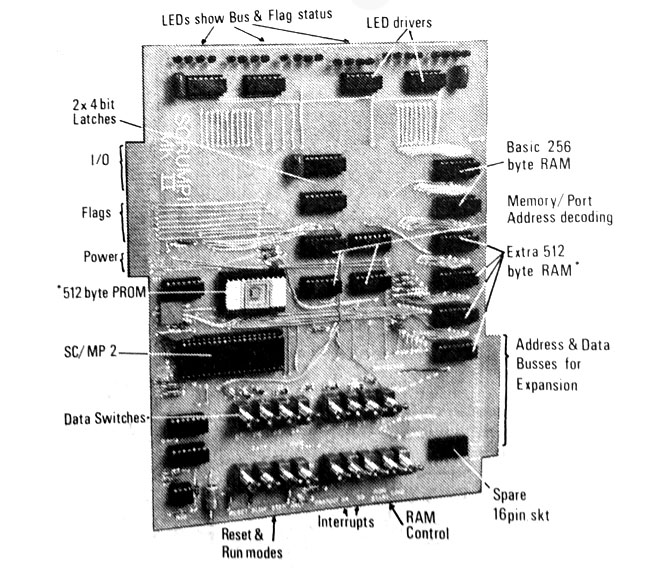
The Scrumpi 2
The cheaper machine was based - as would be Science of Cambridge’s MK14 - on the National Semiconductor SC/MP microprocessor, better known by its nickname, "Scamp". Scrumpi was crude: like the original Altair, it used physical switches as input devices. Sixteen such switches were hooked up to 24 LED bulbs as a readout, all of them connected to the Scamp, a pair of MM2112 Static Ram chips - 256 bytes in all - four 74C173 four-bit latches and a handful of other ICs.
An early ad headlined “Oi loike SCRUMPI!’ and showing a crudely drawn West Country yokel, undoubtedly doodled by Miller-Kirkpatrick himself, said: “The switches allow you to enter a program into the RAM and then exec that program. Several operating modes allow for ease of testing. SCRUMPI can be extended to address up to 64K bytes and can be interfaced to ROM, PROM, RAM, EAROM or many types of IO device. SCRUMPI can also be used to replace a SC/MP in another circuit to give full in-circuit testing facilities.”
Scrumpi-pumpy
Miller-Kirkpatrick explained a few years later: “This simple system used LED lamps to show the status of the 8-bit data lines, the 12-bit address lines and four single-bit IO lines; so as not to unduly load these MPU buses we ran the LEDs from CMOS drivers.
“The SC/MP can be easily single-stepped... it can be persuaded to execute instructions at a very slow speed, manually controlled by the designer at his own speed. This allows simple debugging using the LED lamps... At each step the designer can see exactly what effect the previous executed instruction had on the equipment as a whole and if necessary modify that instruction to do something different.”
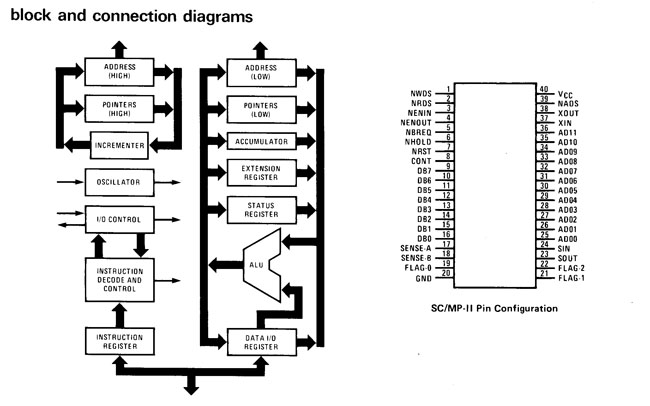
Second-gen Scamp: the SC/MP-II
Reviewers praised the Scrumpi’s low price. “With all the articles on microprocessors that have been appearing recently there must be a number of readers who feel that they will never really understand micros until they have actually used and programmed one, and who are therefore wondering how they can get their hands on a system as cheaply as possible. Bywood’s Scrumpi kit may be the answer as it provides a self-contained development system using the minimum of parts, and at £55.56 costs less than most other solutions,” wrote David Johnson-Davies in the August 1977 issue of Practical Electronics. Johnson-Davies would go on to work for Acorn on the Atom and BBC micros, and to run its software arm, Acornsoft.
Yet Scrumpi was clearly very limited. “Aspiring computer programmers who want to forget about the hardware the moment Scrumpi is working would be well advised not to spend their money on this kit,” warned Johnson-Davies. “It is just not a practical proposition to write more than the simplest of programs on the system.”
Miller-Kirkpatrick was fully aware of this, and even admitted to readers of the Scrumpi’s manual that “you will soon realise that Scrumpi is very limited as it stands because it does no more than light up the LEDs”.
Scrumpi’s successors
But that wasn’t the point. Scrumpi mattered because it allowed punters to learn the basics of microprocessor operation and machine code programming for a relatively modest outlay. It was a foot in the door of the computer world, a stepping stone to the more capable kit Miller-Kirkpatrick knew was only a few years away.
Plenty of other folk understood that too. Scrumpi sold “exceptionally well”, Miller-Kirkpatrick would later claim - some 200 were sold between late 1976 and the end of 1977, an impressive total for the time. The only thing close was National Semiconductor’s own amateur-oriented evaluation system, IntroKit, was then selling for around £70, which was much less than all other evaluation kits offered by chip makers, but the product wasn’t much use without the accompanying KBKit, a calculator-look gadget that hooked up to the IntroKit by way of a ribbon cable and provided a hex keyboard and an eight-digit LED display. KBKit was a further 70 quid.
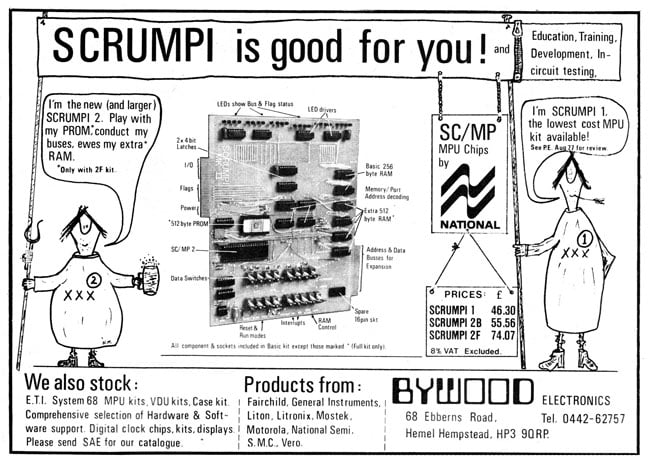
“Oi loikes moi Scrumpi”
Soon after, National Semiconductor began pitching its LCDS (Low-Cost Development System) which had the same keyboard the MK14 would eventually use, along with four 72-pin slots for RAM, ROM, PROM and IntroKit CPU boards and such, all mounted on a large black stand. It cost £335 plus VAT and began to appear around the time that Ian Williamson was building his own Scamp-based processor board out of old Sinclair calculator parts.
Williamson, about to take a job in the motor industry and so no longer able to run a business selling microprocessor training boards, offered his kit design to Science of Cambridge’s Chris Curry. Curry was seeking a follow-up to SoC’s rather poor Calculator Watch offering. He agreed to market Williamson’s product, only to switch to the MK14, a slightly modified version of the National Semiconductor IntroKit, before Williamson’s hardware was put into production.
Williamson worked on his kit during the spring and summer of 1977, the same time that Chris Shelton was designing the Nascom 1 for Lynx Electronics, and Research Machines co-founder Mike Fischer was putting the finishing touches to the 380Z. The Nascom 1 was formally launched in November 1977, while the first 380Zs began shipping in December that year, though the machine had been demo’d in prototype form as early as May.
Scrumpi memories: A user remembers
I can describe parts of it, though with only partial recall. There was a row of switches along the bottom. Four switches handled reset (momentary), single step (momentary), run (momentary) and slow run (toggle). There were eight toggle switches directly on the data bus. I think there were no switches on the address bus, I believe there was another switch for load and address increment (momentary), or maybe separate switches for load and address increment.
 I’m not certain of this, being unable to select an address without resetting and stepping through would have been painfully long-winded in the event of an entry error, but I’m pretty sure there were no switches on the address. I believe there were eight control switches altogether, which means there may have been two more the function of which I no longer recall.
I’m not certain of this, being unable to select an address without resetting and stepping through would have been painfully long-winded in the event of an entry error, but I’m pretty sure there were no switches on the address. I believe there were eight control switches altogether, which means there may have been two more the function of which I no longer recall.
Mine started out with 256 bytes of RAM – no ROM on a Scrumpi – which I soon increased to 512, the maximum for which the board was designed. I then added another 1KB on a small add-on board of my own design. My first program was "Mastermind". Output was very crude, you loaded a register with a value you wanted to display and stopped the processor with that value showing on the data bus.
As there was no ROM, you had to reload everything in binary on power down, so I added a motor-cycle battery as backup power and left it on trickle charge.
I worked for Sperry Univac at the time and got an old scrap CRT terminal and put the Scrumpi inside, and wrote a very small hex monitor program with keyboard and screen routines and a tape interface. Of course, this had to be entered manually in binary, but once loaded, further programming was much more efficient.
It was a very crude device, but the low level of the interface was excellent at teaching the basics of how micro-processors worked and were interfaced to.
Andy Lawrie
Home life
Miller-Kirkpatrick undoubtedly knew that machines like the Nascom and 380Z were coming, along with the likes of the Apple II, Commodore Pet and Tandy TRS-80, which were launched in the US during 1977. He certainly didn’t rest on Scrumpi’s laurels, but times were hard in the Miller-Kirkpatrick household. His daughter Kirsten had been born deaf, and so John moved the family during the long hot summer of 1976 from Hemel Hempstead to the Buckinghamshire village of Chalfont St Peter in order to allow Kirsten to attend the best schools for hearing-impaired kids in the area. He named the house "Tintagel".
His own health was troubled. As a child, he had suffered from leukaemia but the treatment had been seemingly effective. Perhaps it’s that earlier brush with mortality which made John so active in later life. It’s hard not to conclude that he realised early on that life could be short and that we all owe to ourselves to make the most of what time we may have. Either way, around 1976 the disease returned.
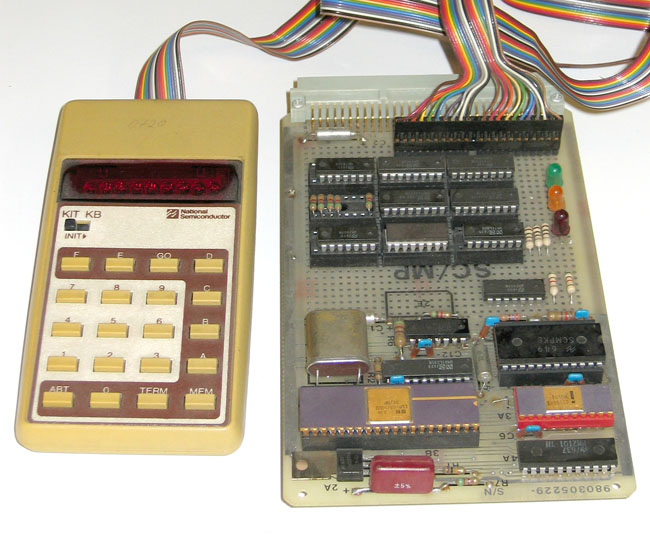
Yours for £140: National Semiconductor’s IntroKit and KB Kit
Source: Colin Phillips
Not that he was one to let this get the better of him, and he continued to show the same fighting, fun-loving spirit as he always had. His daughters both recall John’s keenness on belting around South Buckinghamshire in his Jaguar. “We used to get taken out to country pubs in his Jag,” remembers daughter Kirsten.
“We used to go out for drives which I have since discovered was probably to a) find little country pubs and b) find a new home,” adds her sister, Ashleigh. “Mum said they used to write a list of L, R and then just drive and turn according to the list - this was fairly adventurous and spontaneous, a trait of my dad’s I would suspect.” Sometimes he’d let the kids choose the next turning.
John often took the kids to London on his trips to the ETI offices and the family were at the head of the queue when Star Wars premiered at the Odeon Leicester Square on 27 December 1977.
Inspect a gadget
Play was important to John, but so was work. While his illness soon forced him to work from home - wife Jane would continue to manage the Bywood office in Hemel Hempstead every day - he never let up. Both Kirsten and Ashleigh separately recall encountering him still awake in the wee small hours, still hard at work on electronics projects.
“I used to hate storms when I was a child and woke up during the night one time,” says Kirsten. “However, I found my father in the dining room where he was tinkering away with his electronics work and he allowed me to stay up until the storm passed.”
“I often thought he was up early for breakfast only to discover that he had been up all night!” adds Ashleigh.
The girls grew up surrounded by their father’s magazines, journals, sci-fi books, rock records, that de rigeuer feature of every middle-class 1970s English living room, the tropical fish tank - but mostly his electronics handywork. “Solder kits, chips, circuit boards, wires and pliers, home made digital clocks, a static electric resin door stop and other detailed projects and inventions filled our home,” recalls Ashleigh. The dining room became his make-shift office.
“The carpets often held onto bits of wire, solder and the occasional chip which my dad convinced me were robotic woodlice. I would sit on his knee ‘helping‘ solder and choosing lengths of coloured wire.”
Late nights and family rites
Adds Kirsten: “There was one ‘woodlouse’ that had a wire connected to a remote control that he had made up. Looking back, I’d say it was a genius thing to have done as I don’t know of any such remote controlled ‘toys’ available for sale on the shelves of shops 40 years ago. This ‘woodlouse’ had legs that walked.”
Miller-Kirkpatrick continued to work on his computers too. During 1977, he revised Scrumpi, replacing its processor with the newly released SC/MP-II chip, a lower power, cheaper version of the original Scamp, this time based on NMOS technology. Bywood knocked the Scrumpi’s price down to £46 and released the Scrumpi 2, a physically larger board, at £56. Later in 1977, he tweaked the Scrumpi 2 to add slots for extra RAM and PROM. A more expensive, ‘F’ version of the Scrumpi 2 came with these slots filled, with an extra 512 bytes of RAM and 512 bytes of PROM.
Aware of the major limitations of both the Scrumpi 1 and Scrumpi 2, Miller-Kirkpatrick was already working on a third version and this debuted in the Summer of 1978. No more switches and LEDs - the Scrumpi 3 had a VDU output and a 21-key keyboard: 16 character keys, four mode-selection keys and an "Interrupt" button.
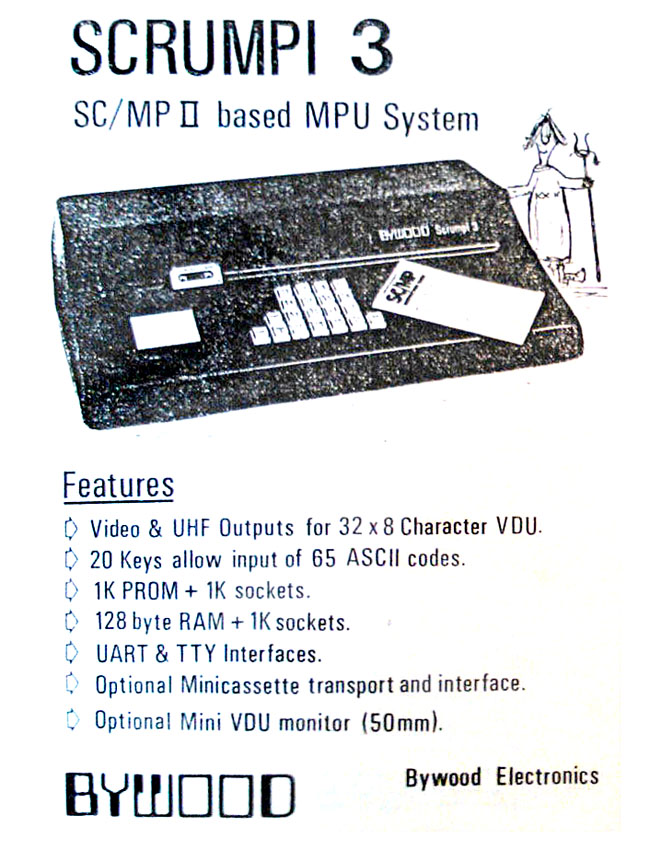
Introducing the Scrumpi Mk III
The Scrumpi 3 was lauded by Electronics Today International as the “cheapest” board micro with a VDU output. “Bywood has managed to squeeze all 64 upper case Ascii characters onto a 21-key keyboard. This is achieved by the use of three shift keys. One soon gets used to using the shift keys and although it would be more convenient for entering hex code if the lower case characters were 0-9 and a-f, the current layout has presumably been chosen to ease a general purpose teletype.”
Unsurprisingly given Miller-Kirkpatrick’s talent for journalism, “the two handbooks are well and entertainingly written, starting from absolute basics and working up, so that someone who had never heard of a microprocessor before would soon be able to use the Scrumpi,” the review noted, though it also said “Bywood consider that ‘the PCB is its own circuit diagram’ and that further documentation is therefore unnecessary.”
Scrumpi Mk 3
Overall, however, the Scrumpi 3 “is nicely produced, fulfils its designers’ requirements and the distributor, Bywood Electronics, are very helpful in the event of any difficulties or problems”.
Customers included “universities, a photographic equipment maker, an airport cargo/passenger scheduling company”, Miller-Kirkpatrick wrote shortly afterwards. Even Sinclair Radionics wanted one, to help demo its personal digital multimeters and 2-inch Microvision pocket TVs at electronics shows.
The third-generation Scrumpi had a 4KB memory map - the furthest the SC/MP-II could go with its 12 address lines - so with 1024 bytes allocated to the VDU, keyboard, UART and other ports, Miller-Kirkpatrick had a further 3KB of addresses to play with: 1KB went on the on-board software monitor, held in ROM, and the rest was linked to two slots, one to take an optional 1KB of RAM, the other for 1KB of extra PROM.
Scrumpi 3 could be yours for £155 - or £190 if you had the cased version, which also incorporated a microcassette recorder for program storage. There was no Basic interpreter, but Miller-Kirkpatrick had a mind to offer one and may even have started work on the software. It might not have been the complete home computer system the Nascom 1 was, but it was considerably cheaper.
“Whether we like it or not, microprocessors are going to enter our everyday life the same way that transistors have done,” Miller-Kirkpatrick wrote that year. It was clear from his journalism he knew the microcomputer revolution had begun and that he wanted to be a part of it.
But that was not to be.
Anticipating the revolution
Quite apart from his illness and the need to bring up two children - with wife Jane out at the Bywood office every day, sorting out the kids every morning and after school fell to John, and he also "home schooled" young Ashleigh for a year - it was a tough time for the electronics and nascent computing business in the UK.
“At present the UK boasts something like six companies making home and small business computers based on microprocessors, my own company being one of them,” he wrote and told the recently launched Personal Computer World around the middle of 1978. “Recently we had 95 per cent of our kits waiting on the shelves for three months due to the ‘memory famine’. During that time, we had to watch the customers dwindle and the bank overdraft charges rise.
“We will soon be able to deliver from stock, but the majority of advertising and selling done three and four months ago has been wasted. Other UK companies are in similar situations for various reasons.”
Miller-Kirkpatrick was writing in response to readers who had been grumbling about the generally high price of computers in the UK compared to those available in the US. Even 35 years ago, this aspect of "rip-off Britain" was bothering technology buffs, just as it still does.
Hard times
John’s rebuttal was clearly put: “There has been some controversy recently concerning the price of American MPU systems in the UK. There are companies who simply change the $ sign for a £ sign and call that the UK price; most are more reasonable.” What many folk forget, he said, is the differences between Britain and America.
“Let us take as an example a reasonably sized American microcomputer system which sells for a basic $2,000. Sales volumes are low because of the relatively high prices of the equipment in the UK. Even if the UK dealer made no profit and sold the example system for £1,000, this probably represents a quarter of the average annual salary for a programmer or engineer, the most likely first customer.
“In the US, the typical engineer or programmer can expect to get about $20,000 per annum; our $2000 example is equivalent to only one tenth of his salary.”
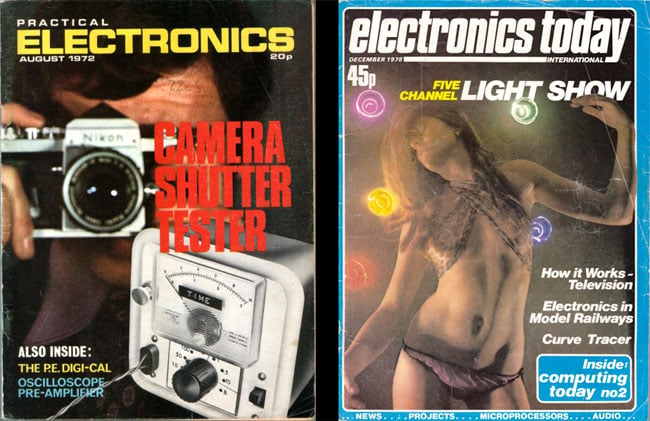
Chalk... and cheese: in the mid-1970s, the brash Electronics Today (right) was very different from the staid Practical Electronics (left)
Microcomputers were only going to be popular, then, if they became much cheaper. Thanks to Clive Sinclair, they soon would be. But John Miller-Kirkpatrick, who with the Scrumpi series had established the notion of low-cost but functional computer for everyone, would not witness the explosion in interest in home microcomputers to come.
Toward the end of 1978, Miller-Kirkpatrick’s illness took a turn for the worse. By now Jane Miller-Kirkpatrick had been forced to spend less time on Bywood. In order to make ends meet, she had studied accountancy part time and then set up a bookkeeping business. But perhaps she and John also understood she would need to call on such a practical skill when eventually her husband would no longer be able to contribute the articles and electronics designs that had kept Bywood in business.
The leukaemia became more severe, and on 12 December 1978 Miller-Kirkpatrick died. He was only 32 years old.
A pioneer, lost
“John Miller was very nearly a genius but above all he was a damned good chap: I don’t think there was an ounce of badness in him,” wrote ETI Editor Halvor Moorshead. “I will miss him but our hobby will miss him as well.”
Had he lived, it’s entirely possible Miller-Kirkpatrick would have beaten Clive Sinclair to get the first low-cost cased computer to market. That was clearly the logical next step for the Scrumpi series: make a more capable, more compact cased machine. It would likely be based on a more powerful processor than the limited Scamp: Zilog’s Z80 perhaps or Mostek’s 6502, but more probably Motorola’s 6800. Whatever the specification, it would have been priced well below £200.

Happier times: John Miller-Kirkpatrick in the mid-1970s
One-time Register writer and veteran British technology journalist Martin Banks thinks so. "Today, the Scrumpi would be laughed at for masquerading as a computer," he once wrote in his PCW column, Banks’ Statement, "but with some better backing and some reasonable financial support, Miller-Kirkpatrick could have beaten Clive Sinclair at his own game."
Miller-Kirkpatrick was clearly thinking about low-cost complete computer systems in the two years before his death. “Another main application of MPUs is in the area of small, low cost computers for use in business applications and in the growing Personal Computer market,” he wrote in a 1978 business plan.
“We see one product which is able to cover both markets without restricting the possible applications because of price, the product would be based on a proven ready built main processor with such options as printers, random-access disk-based memory systems, magnetic tape systems and a programming language which allows the user to write simple programs or to make use of the various ‘package’ programs available.”
Connected future
More than three years before the BBC Micro, Miller-Kirkpatrick was planning to investigate the use of the Teletext system as a cheap way of adding colour graphics and text to “a ready built microcomputer system for home or business applications”. It would by definition be compatible with the broadcast Teletext and the Post Office’s Prestel system too.
But John’s death ensured these concepts would be for other people to re-formulate and develop. In the year after Miller-Kirkpatrick died, Nasco launched the Nascom 2, though it would take many months to get it into the hands of buyers. As it began to arrive, Tangerine began selling the Microtan 65.
Science of Cambridge would continue to offer the MK14 kit during 1979, but with Chris Curry gone - the Acorn Microcomputer debuted in January 1979 - Clive Sinclair told his long-term technical collaborator, Jim Westwood, to develop a new, cased computer.
The ZX80 débuted early the following year. Six months later, Nasco went into receivership. It would survive for some years, initially in administration, later as a Lucas subsidiary, but its place at the peak of the UK home computer business had been wrested from it by Sinclair Research, which was soon joined by Acorn after it launched the Atom home machine in May 1980.
Proton followed Atom and became the BBC Micro; Sinclair shipped first the ZX81 and then the Spectrum. In all the furore surrounding the UK home computer boom, the 1970s pioneers were largely forgotten. But without their ground-breaking start, the market might have developed very differently.
Legacy
Britain found itself at the forefront of a new industrial revolution. And if the first industrial revolution is remembered more for the industrialisation that took place in the 18th and 19th centuries rather than the 17th century breakthrough which triggered it - discovering how to cast iron - so the first board microcomputers were the trigger for the 1980s IT boom.
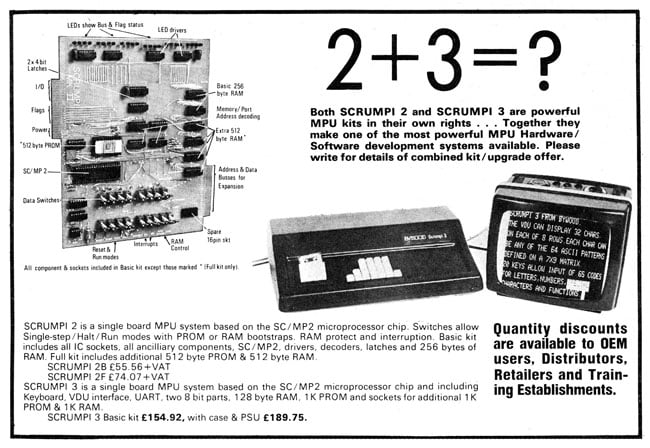
Expanding the range in 1978
The Scrumpi was feeble even by the standards of the machines that very quickly followed it. So was the MK14 and others of the Scrumpi’s ilk. But, crucially, Miller-Kirkpatrick’s machine gave many of the tech enthusiasts who would soon join the exploding number of home computer companies and the software firms that orbited around them, not to mention the rapidly growing world of business computing, their first taste of microprocessors and microcomputing.
“John Miller-Kirkpatrick and his Scrumpi computer have a place in the history of the personal computer business,” wrote Martin Banks in 1983. “Many of the people presently working in the industry got their early experience on such a machine.” ®
I would especially like to thank Kirsten and Ashleigh Miller-Kirkpatrick for their invaluable help with the research of this feature and for giving me access to family documents.
